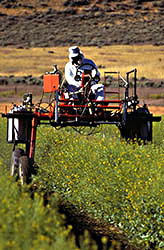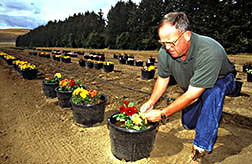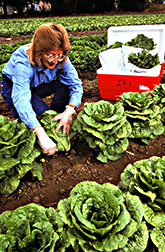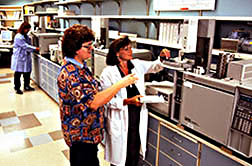 At the Yakima Agricultural Research Laboratory in Wapato, Washington, technician Tom Treat applies a test pesticide to a rapeseed variety being grown for canola oil production. (K7433-13) |
IR-4 Projects Protect "Minor" Crops
Agricultural chemical producers readily test and seek U.S. Environmental Protection Agency (EPA) approval for new pesticides for blockbuster crops like corn and wheat.
That's because there's a potential to market a product that can be used on from 70 to 80 million acres. The chemicals industry recoups its investment and makes a profit.
Other, smaller crops like mint and cucumbers are generally not worth the industry's attention. But these minor crops—defined as those grown on 300,000 acres or less—are helped by a federal-state project known as Interregional Research Project No. 4, or IR-4. Its charge is to conduct field trials and collect data needed for EPA approval of so-called minor-use pesticides.
"But "minor" can be misleading," says Richard T. Guest, national director of the IR-4 program. He's stationed at the New Jersey Agricultural Experiment Station at Rutgers University in New Brunswick.
"According to the most recent census of agriculture, 11 million acres of minor crops are grown annually in the United States," says Guest. "They have a combined value of $32 billion and represent 42 percent of all crop sales. In 27 states, these minor crops exceed the value of all the other major crops including corn, cotton, soybeans, and wheat."
"Minor use" can also mean the infrequent use of a chemical product on high-acreage crops like corn and wheat. Last year, the IR-4 project was responsible for 104 minor-use pesticide clearances; in 1994, there were 141.
Since its inception in 1963, IR-4 has assisted with more than 4,400 clearances on some 208 crops, from acerola (Barbados cherry) and alfalfa to yam and youngberry. While some of these crops have odd-sounding names like canistel (a tree fruit grown in Florida) and kenaf (a plant that is being used for newsprint), most can be found in the fresh produce section of any supermarket.
The IR-4 Ornamentals Research Program, which was added in 1977, has resulted in more than 3,600 additional pesticide clearances for 263 commercially grown floral and nursery crops—from abelia and acacia to zebra plant and zinnia.
The program took on even more importance when its role was expanded in 1982 to include registration of biopesticides. This is a commitment to develop alternatives to chemical pest controls. IR-4 interacts with the U.S. Department of Agriculture (USDA), the U.S. Food and Drug Administration (FDA), and EPA to determine what data will need to be collected.
As a result of this cooperation, 68 biopesticides have been approved. One of these is granulosis virus to control codling moths that attack apples, pears, walnuts, and plums. Another is cinnamaldehyde for the control of Verticillium spot and dry bubble disease of mushrooms.
"The program is important to protect growers and consumers. It enables farmers and ranchers to use pesticides judiciously against weeds, diseases, and insects. Otherwise, some might be tempted to spray anything that works and at incorrect rates. Because of IR-4, consumers get foods that are wholesome, safe, and relatively inexpensive," says Paul H. Schwartz, Jr.
Schwartz coordinates the IR-4 program for USDA's Agricultural Research Service at Beltsville, Maryland. USDA's Cooperative State Research, Education, and Extension Service is the lead agency. Regional laboratories servicing satellite locations are Davis, California; East Lansing, Michigan; Geneva, New York; and Gainesville, Florida.
"As a matter of fact," says Schwartz, "we believe the program may actually reduce overall pesticide use. Once we have all the data, we learn the proper doses farmers should be using. If that information weren't on the product label, they might apply more than they actually need. That would raise their costs and put more chemicals into the environment."
Plenty of Grower Input
"One of the reasons IR-4 is so successful is that it's a real grass roots program," says Guest. "We have workshops open to growers, grower groups, researchers, and any interested parties. They tell us what pest problems they have, and that's what we work on."
And, he adds, having a close working relationship with EPA streamlines communication and produces results more quickly.
Each trial looks at how effective the chemical is, how it might affect the crops, how much to apply, and how much, if any, of the chemical remains on harvested crops. There are 10 ARS test sites across the country representing diverse climates.
These are at Wapato and Prosser, Washington; Corvallis, Oregon; Salinas, California; Urbana, Illinois; Wooster, Ohio; Weslaco, Texas; Beltsville, Maryland; Charleston, South Carolina; and Tifton, Georgia.
Scientists at three ARS analytical chemical residue lab—at Wapato, Tifton, and Beltsville—determine the amount of residue remaining on commodities after treatment, so a tolerance level can be established. The minute amount of chemical residue allowed to remain on commodities falls within a safety margin set at least 100-fold below a no-effect level.
Data from laboratory research and replicated field trials is incorporated by IR-4 headquarters into petitions and submitted to EPA. The petitions are a request that a tolerance or exemption be established for a specific product on a specific crop. The process generally takes from 3 to 5 years, depending on the difficulty of the study and EPA review time.
During the fiscal year that ended September 1996, $8.3 million in federal funds supported the IR-4 program. State agricultural experiment stations contribute additional funding. Private industry also contributes.
Testimonials From IR-4 Fans
"Survival," says Ann George, "is what the IR-4 program means to the hops industry. We're still in business." And that's important, for today's U.S. hops industry is a healthy one with an annual crop valued at $137 million—about 28 percent of the world's production.
But back in the late 1980's, things looked pretty bleak when hops growers lost registration on the primary miticide, herbicide, and insecticide they needed to stay competitive in a worldwide market.
“After using emergency exemptions from EPA on a year-by-year basis, we have now obtained full registrations for a key insecticide and a miticide,” says George. She is administrator of the Washington Hop Commission, as well as administrator of the U.S. Hop Industry Plant Protection Committee in Yakima, Washington.
George says the pesticide industry was unwilling to gather data and petition EPA for labels that would permit use of the products on 42,000 acres of U.S. hop—a drop in the bucket compared to the market potential of nearly 80 million acres of corn.
 The IR-4 program also checks out chemicals applied to ornamentals like these dahlias being examined by technician Tom Treat for evidence of damage. (K7433-12) |
Charles Matthews has a similar story. He's a representative with the Florida Fruit and Vegetable Association in Orlando.
"The IR-4 Program assisted in providing data for certain uses of an improved insecticide—imidacloprid," says Matthews.
"Growers are now allowed to use a single application of this chemical to control silverleaf whitefly on their tomatoes and melon thrips on peppers. Some other previously registered insecticides required up to 20 sprays to knock down insect populations.
"And," he adds, "imidacloprid is not harmful to beneficial insects and is compatible with integrated pest management programs."
But when EPA required that its use entail a crop rotation, many growers were reluctant to switch from growing high-value crops to less-income-producing ones. Back came IR-4 with data supporting the safety of planting high-value crops like cucumbers, squash, and melons after the tomatoes and peppers were harvested.
"This is an excellent example of what growers, IR-4, university scientists, private industry, and EPA can accomplish when we work toward a common goal," says Matthews.
In dry onions, pendimethalin was approved for weed control. It is more effective and controls a broader spectrum of weeds than the major alternative herbicide, and growers need apply only about one-tenth as much. While it costs more per unit, the net result is that farmers pay only one-fifth of what they used to pay for the alternative.
Gene Batali, who grows 250 acres of spearmint near Wapato, says, "We need to control weeds in our mint fields. If any are harvested with the crop, we end up extracting their oils along with that from the mint.
“Now we have control over our weeds because IR-4 was the vehicle we used to get the required herbicide registration.”—By Dennis Senft, ARS.
Paul H. Schwartz, Jr., is on the USDA-ARS Pesticide Research Staff, Bldg. 10300 Baltimore Ave., Beltsville, MD 20705-2350; (301) 504-8256, fax (301) 504-5048.
NAPIAP Assesses Pesticide Impacts
|
A Brief IR-4 Timeline 1963—Interregional Research Project No. 4 organized by directors of state agricultural experiment stations in cooperation with U.S. Department of Agriculture. 1976—ARS program formally established to assist IR-4 with backlog of clearance requests. 1977—IR-4 expanded to include commercially grown ornamentals, such as floral and foliage plants, woody nursery stock, Christmas trees, and turf grass. 1982—Scope expanded to include research supporting registration of biopesticides, such as microbials and biochemicals. More recently, genetically engineered material was added to the mission. 1989—IR-4 strategic plan developed to gather data for reregistering by 1997 nearly 1,000 minor use labels mandated by amendments to Federal Insecticide, Fungicide, and Rodenticide Act. 1995—Goals identified for the next 7 years, providing for a shift in program emphasis to increase the number of registrations for both biological pest control agents and less potent products needed in integrated pest management programs. |
The primary mission of USDA’s National Agricultural Pesticide Impact Assessment Program is to promote informed regulatory decisions on registered pesticides. NAPIAP was established to move information from USDA to EPA’s process of weighing risks against benefits, as described in our federal pesticide law.
The mission is accomplished by managing and coordinating USDA and state efforts to develop and analyze information on pesticide use and pest control practices. That includes assessing what happens if a pesticide is no longer available for use on a particular crop to control insects, diseases, or weeds. NAPIAP estimates the costs to farmers and consumers of losing pesticide uses, while taking into account any issues related to human and animal health or the environment.
NAPIAP and IR-4 have a common interest in the availability of adequate pest control tools. Although the two programs are separate, their common interest has led to cooperation. While IR-4 is charged with seeking registration—or reregistration—for new uses of existing chemicals on minor crops, NAPIAP gathers and analyzes information on pesticides already approved for both minor and major crops.
“Our documents are designed to provide unbiased information in a timely manner when questions about pest management and crop production arise, particularly in relation to EPA’s regulatory activities and decisions,” says Nancy N. Ragsdale, NAPIAP director. “We need to be prepared to react when regulatory actions are being considered, rather than after they have become law.” She says the most recent report the office prepared was on rice; it was one in a series of assessments of pesticide use on various commodities.
“If we were asked specific questions on the value of a specific herbicide to control weeds in rice fields, we’d be able to pull the information together quickly. This helps assist EPA early in the regulatory process,” says Ragsdale, whose position is funded by ARS. Other participating agencies include USDA’s Cooperative State Research, Education, and Extension Service; Economic Research Service; and Forest Service.
NAPIAP was chartered by acting Secretary of Agriculture Knebel 20 years ago, in October 1976. It reports to the Office of the Under Secretary for Research, Education, and Economics.
"IR-4 Projects Protect "Minor" Crops" was published in the October 1996 issue of Agricultural Research magazine.








